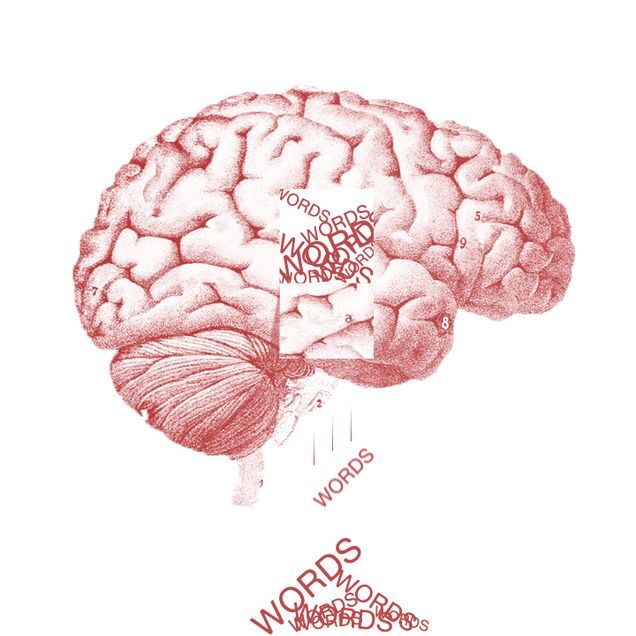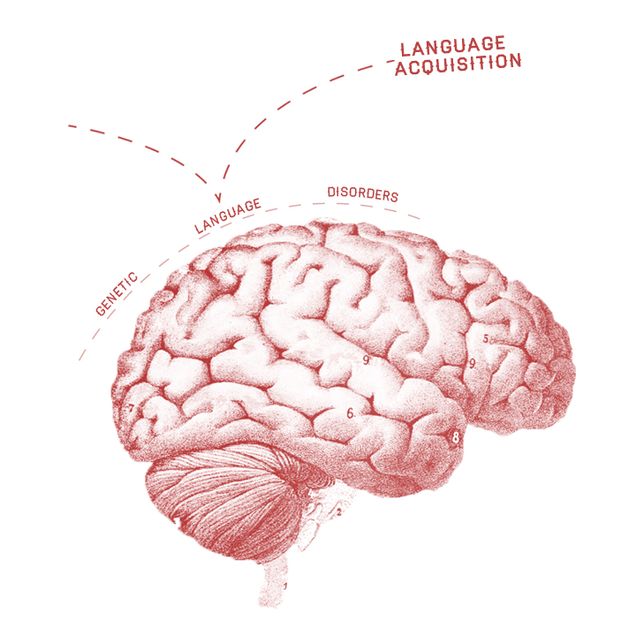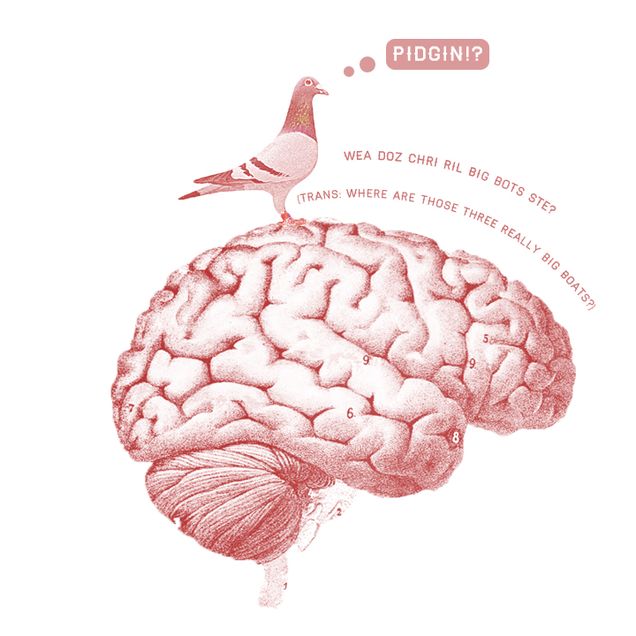For the Love of Language
An exploration of human language and how it develops.
Imagine that you are in a foreign country. You get into a taxi and begin to explain where you want to go. But, with frustration, you realize that the driver does not understand you. Speaking slowly and repetitively, you struggle, finally communicating your intended destination. Such a language barrier can frequently be encountered abroad, but can you imagine a lifetime without language? You are neither mute nor deaf. Rather, you have lost the ability to record your experiences with descriptive words, to convey your ideas to others in speech or writing, and even to speak to yourself as you go about your day. Surprisingly, an ability as fundamental to humans as language must still be acquired over time. Hereditary language disorders and abnormal upbringings reveal the role that genetics and environmental input play in developing language.
Talking the Talk
Language acquisition is one of the few mental challenges that children master effortlessly and without instruction.1 Genetics provide all healthy children with language-specific circuitry so that mere exposure to environmental input leads to rapid acquisition. With adequate environmental input, children can cultivate an extensive vocabulary and acquire a mental grammar of the language.2 Vocabulary aside, a child’s language comprehension (but not speech) approximates adult competence by age five.3 However, with language, timing is essential. Complete growth of the brain’s language areas occurs only during the “critical period”, a developmental time between ages two and seven. Language is most easily acquired throughout the duration of this period, during which the brain’s neural circuitry is easily modified in response to environmental input.4 Outside of the critical period, the ability to acquire language decreases rapidly.2 Children who are exposed to their first language as teenagers (e.g., feral children) develop a poor vocabulary and are unable to master complex grammar rules including sentence structure, plurals, and past tense usage. Feral children produce sentences like “I hit ball” or “cupboard put food”. Though these individuals are genetically normal, no amount of experience, instruction, or encouragement can allow for fluency to develop.2 Thus, both proper genetics and early environmental input are necessary to acquire language.
Language and Genetics
Genetic language disorders demonstrate that language needs certain neural foundations. Specific Language Impairment (SLI) is a genetic disorder that delays and impairs language use and comprehension. It is inherited through a dominant gene and is passed on to fifty percent of children with an affected parent. Individuals with SLI perform normally on nonverbal tests of intelligence, but they display slow and ungrammatical speech throughout their lives. They may say sentences like, “the boy eat three cookie.” Their speech lacks language basics, which any child with the necessary genes can easily master. Sentences like these occur because individuals with SLI are unaware or unable to identify rules governing word formation. However, these deficits are not due to the linguistic environment created by an affected parent, as some of these individuals have siblings with normal language. Even with intensive language therapy and correction, these individuals do not demonstrate improvement in their language abilities. For example, these children could not pluralize a made-up word such as “wug’. However, most children over the age of seven can always produce the correct plural, “wugs”1. This evidence suggests that a genetic flaw in SLI individuals limits neurological development in areas of the brain associated with language. Yet, this genetic abnormality spares the development of other cognitive areas. It can therefore be concluded that, without proper genetics, general intelligence and adequate environmental input are not enough to master language.
Williams syndrome is yet another type of genetic disorder that illustrates language acquisition and development in spite of low intelligence, indicating that language acquisition is the result of language-specific genes. Williams syndrome is caused by a defective gene on chromosome 11, which results in individuals with significant mental retardation. Although their linguistic knowledge develops more slowly and to a lesser extent than their peers, individuals with Williams syndrome still develop vocabulary and language that is impressive considering their cognitive deficits. Affected individuals can speak fluently and utilize concepts such as plurality and past tense usage.5 Even with significant mental retardation, language acquisition can still proceed relatively well; language must be genetically coded separate from general intelligence.
Nature and Nurture
The development of early language in deaf children demonstrates to what point acquisition can progress with proper genetics but inadequate environmental input. Deaf children born to non-deaf parents may not be exposed to sign language during the critical years of language development. Even without linguistic input in their environments, they still invent a homemade system of signs so that they can communicate with their parents. “Home sign” systems found among a group of deaf children shared common characteristics with signed and spoken language. Children made eye contact and used a system of abstract gestures rather than simply pointing to the objects they were talking about. The gestures were signed in series separated by pauses just like sentences of any spoken or signed language. Finally, the gestures conveyed a consistent meaning whenever they were used. However, because of a deficit in environmental input, these children never developed the ability to construct complex sentences.1 Later exposure is ineffective because these children are often near the end of the critical period. Yet, it seems extraordinary that communication, similar among these children, developed without linguistic input. This phenomenon suggests that genetics provides a strong foundation for language acquisition, but environmental input is essential to reach adult competence with language.
The development of Hawaiian Creole constitutes an example of how the genetic basis of language allows children to cope with imperfect (but adequate) input. In the late 1800s, a need for immigrant laborers on Hawaiian sugar plantations created an environment for the development of a new language. Workers from many different countries needed a language to communicate among themselves and with the English-speaking plantation owners. The solution was a makeshift communication system called a pidgin. Pidgin speakers use words from the socially or economically dominant language to form sentences. Yet, these sentences lack consistent word order, use of function words (articles, prepositions, etc.), and complex sentence structure. When exposed to the pidgin, the children of these immigrants did something extraordinary: they developed a new, complex, and consistent language now called Hawaiian Creole. Even though no extended period of time allowed adult speakers to make these changes, their children easily constructed a consistent and complex language just by hearing the pidgin during their development.6 There are several hypotheses for why such a rapid and complex transformation occurred. First, the children may have drawn on the sentence structure of English as a basis for Hawaiian Creole. This, however, seems unlikely because pidgin speakers had little contact with English speakers. Moreover, its sentence structure is unlike English. Alternatively, children may have drawn on structures from the native language of their parents. However, children rarely learned the languages of their parents due to intermixed marriages and other social settings in which pidgin was the only common language. A rapid, consistent and complex transformation of the pidgin grammar among all children suggests that specific default properties of language exist in genetics. During the critical period, children have access to and impose their innate knowledge onto language even when they are presented with imperfect input. In fact, further study of pidgins from around the world, has shown that Hawaiian Creole shares striking similarities in grammar with other Creoles. 6 Pidgins may be the clearest evidence for an innate and highly specific knowledge about language, which allows children to create rule-based, complex structure when little or none exists.
Concluding Words
Even though language is fundamental to humans, complete language development is not certain. Fortunately, the study of underdeveloped language provides a clear basis for understanding the requirements of acquisition. Hereditary language disorders demonstrate that the necessary foundations for language are built into our DNA. Other linguistic studies of language development in deaf children and the formation of pidgins highlight the role of environmental input. However, even though acquiring complex language is uniquely human, it is unlike all other human abilities and inventions. Language is neither the result of culture nor of high general intelligence or conscious, systematic study. In fact, it is the result of a complex interaction between genetics and environmental input. Though complete acquisition is not certain, to some extent, all humans can communicate. Language is so fundamental and innate that we can never truly know what it is like to exist without language, no matter where in the world we are.
References
1Jackendoff, R. (1994). Patterns in the Mind: Language and Human Nature. New York,
NY: Basic.
2Alrenga, P. Critical Period Effects in Language Development. Class Lecture. Language and Mind. Boston University, Boston, MA.
3 Yang, C.D. (2006) The Infinite Gift: How Children Learn and Unlearn the Languages of the World. New York: Scribner.
4 Squire, L. R. (2008) Fundamental Neuroscience. Amsterdam: Elsevier / Academic.
5 Pinker, Steven. (2007). The Language Instinct: How the Mind Creates Language. New York: HarperPerennial ModernClassics..
6 Bickerton, Derek. (1983). Creole languages. Scientific American: 116-22.




May 7, 2012
Awesome!!!!!!
May 9, 2012
Great job with the logical progression – SLI, Williams, children of Deaf, and then Hawaiian Creole. Very interesting!
May 10, 2012
Fascinating, and very well written. Great work, Ian!
May 11, 2012
Great article, Mr. Schwartz!